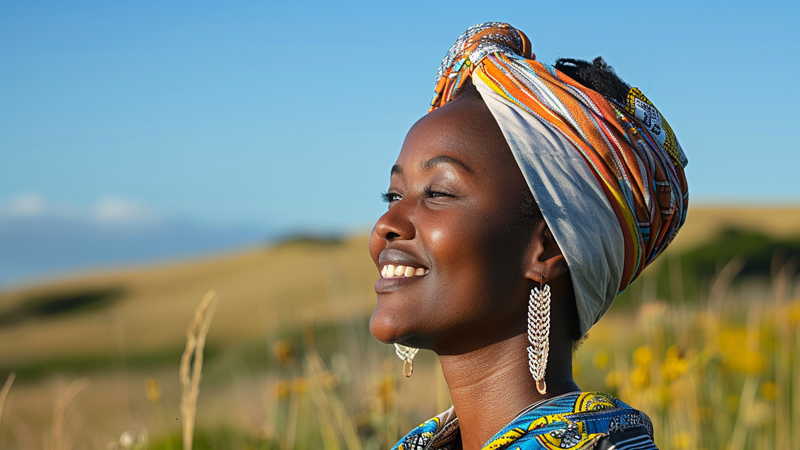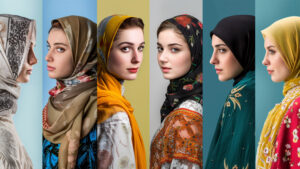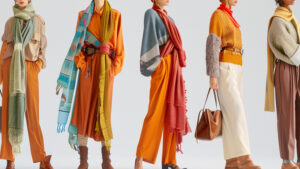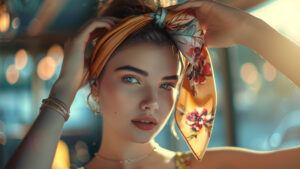
I’ve always loved how a simple hair accessory can change my entire look in seconds.
Head wraps, headbands, turbanettes, turbans, and scrunchies each serve unique functions, styling options, and cultural backgrounds.
Let’s discover how they differ.
What are the functional purposes of each accessory?
These items might look similar at first glance, but they serve different needs.
Head wraps offer full coverage, headbands keep hair out of the face, turbanettes blend style with partial coverage, turbans cover hair entirely, and scrunchies secure ponytails.

Distinguishing Roles and Benefits
Choosing the right accessory often depends on function. A head wrap, for instance, can shield your hair from sun damage or protect delicate edges, especially if you’re someone like me who experiences frizz on humid days. Headbands, by contrast, are all about practicality and minimal coverage. I wear one when I’m cooking or working out; it keeps sweat off my forehead and my hair out of my eyes.
Turbanettes sit somewhere between a full head wrap and a headband. They offer partial coverage while leaving a bit of hair exposed, adding that extra flair without the commitment of wrapping everything. Turbans, on the other hand, encapsulate your head entirely. I’ve found turbans1 especially helpful when I don’t have time to style my hair or need additional warmth. They feel secure yet stylish—like having a beanie that’s a bit more elegant.
Scrunchies, meanwhile, focus on tying up hair without the usual tension of elastics. Their soft fabric is gentle on hair strands. If you’re prone to breakage, a scrunchie can be a lifesaver. It’s also a playful accessory; I often use them to add a pop of color to a casual ponytail. While head wraps2 and turbans can be statement pieces, scrunchies3 are a quick fix for everyday convenience.
But no matter which accessory you pick, each comes with distinct advantages. Some help with hair protection, others offer quick style solutions, and a few do both. By knowing their core purpose, it’s easier to choose the right one for any situation—be it a brisk morning run or a fancy night out. It’s kind of like having different shoes for different occasions; your hair accessories should match your needs and mood just as well.
How do styling techniques vary uniquely for each accessory?
It’s amazing how one accessory can be worn so many ways.
Head wraps can be twisted or folded, headbands slipped on, turbanettes pinned or tied, turbans shaped, and scrunchies wrapped or layered.

Exploring Unique Looks
When I first started experimenting with head wraps, I was blown away by the sheer creativity involved. You can wrap them into a high knot, a low bun, or twist them around to make them look like a decorative crown. Some days, I’ll stick a flower pin on the side to add a touch of springtime charm. With headbands, the styling is simpler but still versatile. Placing it over a slicked-back ponytail can elevate a sporty look, while wearing it closer to the hairline gives a retro ‘60s vibe.
Turbanettes seem custom-built for “boho-chic” flair. I like leaving a few tendrils of hair out for a laid-back style that feels effortless. If you’re going for something more polished, you can tuck all your hair underneath and let the turbanette shine as the centerpiece. Full turbans take a bit of practice, but once you master the folds and tucks, you have an accessory that can stand out or blend in, depending on your chosen fabric and color.
Scrunchies are maybe the easiest to style: a simple twist around your ponytail or bun, and you’re done. Yet you can also stack multiple scrunchies4 for a playful, layered look. I’ve even tied a small scarf around a scrunchie for a more unique spin.
One thing I’ve noticed is that these accessories adapt to different hair lengths and textures. Whether you have curly, straight, or wavy hair, there’s always a creative way to wear them. Learning new tying methods or adding small embellishments can take your style from basic to head-turning. Don’t be afraid to experiment or to mix and match. After all, each item is an open canvas for your personal flair.
What material and design variations exist among them?
It’s fascinating how fabric choices can transform the same shape into something entirely different.
Cotton, silk, and polyester blends are common; designs can be solid, printed, lace-trimmed, or embellished with beads.

Thinking Beyond Fabric
I recall finding a gorgeous silk head wrap5 at a local market. Its smooth texture added a level of elegance I never experienced with my usual cotton wraps. Silk is lightweight, shiny, and often better for reducing friction. It’s a great option if you want to pamper your hair or dress up for a special occasion. Cotton, meanwhile, is breathable and perfect for everyday wear—especially in warmer climates. It’s also easy to clean and maintain.
Polyester blends are the all-around champions of durability. They handle wear and tear well, which is important if you’re like me and sometimes forget to hand-wash delicate fabrics. I’ve also come across lace-trimmed turbanettes that lend a romantic touch, ideal for weddings or date nights. Meanwhile, headbands with beads, sequins, or metallic stitching can stand out even in a room full of fashion-savvy folks.
Scrunchies come in all sorts of materials, from velvet and faux leather to scrunched satin that feels ultra-luxe. The color and print possibilities are endless. You can go for floral patterns that scream “springtime,” polka dots for a playful vibe, or stay classic with a single-colored piece.
The beauty of these variations is how they let you express yourself. A bold print can instantly become a conversation starter, while a neutral design blends into almost any outfit. There’s also the option of custom designs6, if you truly want something unique. Fabric choice can determine comfort, aesthetics, and how the accessory interacts with your hair. Knowing the pros and cons of each material helps you pick something that fits your lifestyle and personal taste—like choosing the perfect coffee blend to match your morning mood.
| Accessory Type | Popular Materials | Typical Designs |
|---|---|---|
| Head Wrap | Cotton, Silk, Rayon | Solid, Prints, Textured, Beaded |
| Headband | Polyester, Metal Base | Patterned Fabric, Embellished, Simple |
| Turbanette | Knit Blends, Lace | Lace Trim, Minimalist, Bold Colors |
| Turban | Silk, Velvet | Ornate Embroidery, Beads, Geometric |
| Scrunchie | Satin, Velvet | Plain, Patterned, Sequins |
What cultural significance and origins do each accessory hold?
Each piece carries a heritage that’s often deeply meaningful.
Head wraps, turbans, and headbands come from diverse global traditions, representing everything from modesty to social status.

Exploring Rich Histories
I remember the first time I learned about African head wraps7, often called “gele.” They’re not just stylish; they’re part of a cultural identity, worn for both daily life and special events. In many regions of Africa, the way you tie or position a wrap can convey your marital status or your sense of pride in ancestral roots. Meanwhile, in parts of the Middle East or South Asia, turbans hold religious significance8, often linked to tradition and devotion. Sikhs, for example, wear turbans as a sign of faith and equality.
Headbands, while simpler in design, also trace back to ancient civilizations. Think of ancient Greece, where laurel wreaths or headbands were symbols of victory and honor. Over time, they evolved into everyday accessories for holding hair in place but never lost that symbolic spark. Turbanettes might not have a singular historical root, but they’ve popped up in different cultures as a more casual or modern spin on the traditional turban.
Scrunchies, of course, feel like a more recent phenomenon, bursting into fashion during the late 1980s. Yet even they have their place in cultural memory—representing a certain carefree, bold style that defined an era. They’re now making a comeback, bridging nostalgic flair with modern convenience.
Understanding these origins can shift how we see these items. They’re not just fashion statements; they’re portals into art, history, and social customs. Wearing one can be a personal choice or a nod to a heritage you hold dear. Sometimes, people even adapt these items to celebrate a global mix of influences, merging designs from different places into one cohesive piece. It’s remarkable how a small accessory can embody so much cultural richness, bridging the past and present in a single wrap, band, or scrunch.
Conclusion
Embrace each accessory’s unique form and background, and let them inspire new ways to express your individual style.
-
Discover the advantages of turbans for both styling and warmth, perfect for busy days or cold weather. ↩
-
Explore the benefits of head wraps for hair protection and styling, especially in humid conditions. ↩
-
Learn how scrunchies can help prevent hair breakage and offer a stylish solution for ponytails. ↩
-
Learn innovative ways to incorporate scrunchies into your hairstyles for a fun and playful touch. ↩
-
Explore the luxurious benefits of silk head wraps for hair care and style, enhancing your accessory game. ↩
-
Learn how to create unique custom designs for hair accessories that reflect your personal style and creativity. ↩
-
Explore the deep cultural meanings and traditions behind African head wraps, enriching your understanding of this beautiful heritage. ↩
-
Discover the profound religious and cultural importance of turbans across various societies, enhancing your appreciation for this tradition. ↩




